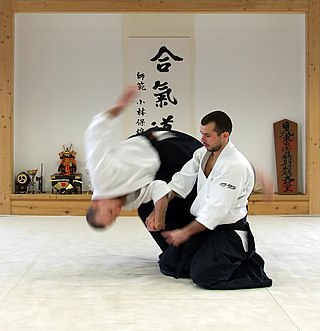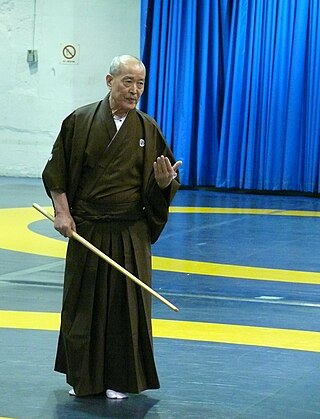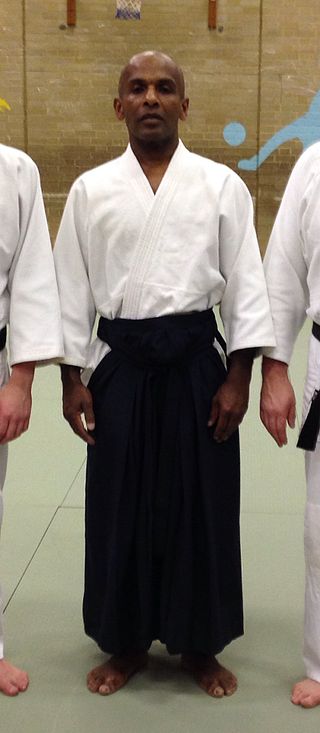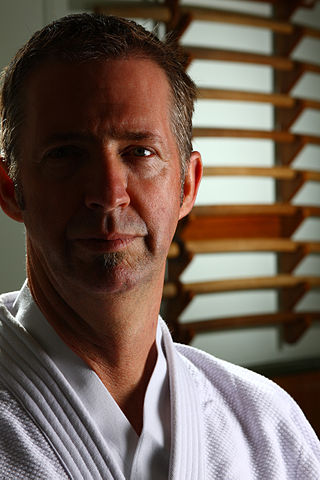
Aikido is a modern Japanese martial art that is split into many different styles, including Iwama Ryu, Iwama Shin Shin Aiki Shuren Kai, Shodokan Aikido, Yoshinkan, Renshinkai, Aikikai and Ki Aikido. Aikido is now practiced in around 140 countries. It was originally developed by Morihei Ueshiba, as a synthesis of his martial studies, philosophy and religious beliefs. Ueshiba's goal was to create an art that practitioners could use to defend themselves while also protecting their attackers from injury. Aikido is often translated as "the way of unifying (with) life energy" or as "the way of harmonious spirit". According to the founder's philosophy, the primary goal in the practice of aikido is to overcome oneself instead of cultivating violence or aggressiveness. Morihei Ueshiba used the phrase masakatsu agatsu katsuhayabi" to refer to this principle.

Daitō-ryū Aiki-jūjutsu, originally called Daitō-ryū Jujutsu, is a Japanese martial art that first became widely known in the early 20th century under the headmastership of Takeda Sōkaku. Takeda had extensive training in several martial arts and referred to the style he taught as "Daitō-ryū". Although the school's traditions claim to extend back centuries in Japanese history there are no known extant records regarding the ryū before Takeda. Whether Takeda is regarded as either the restorer or the founder of the art, the known history of Daitō-ryū begins with him. Takeda's best-known student was Morihei Ueshiba, the founder of Aikido.

The Aikikai is the original school of Aikido. It is centered on the Aikikai Foundation in Japan, and its figurehead is the Doshu. It is represented globally through the International Aikido Federation.
YoshinkanAikido is a style of aikido that developed after World War II in the Yoshinkan Dojo of Gozo Shioda (1915–1994). Yoshinkan Aikido is often called the "hard" style of aikido because the training methods are a product of Shioda's grueling life before the war. Shioda named his dojo "Yoshinkan" after a dojo of the same name that was built by his father, a physician, who wanted to improve both physical and spiritual health. The Yoshinkan style is currently the second largest aikido organization worldwide.

Koichi Tohei was a 10th Dan aikidoka and founder of the Ki Society and its style of aikido, officially Shin Shin Toitsu Aikido, but commonly known as Ki-Aikido.
Gozo Shioda was a Japanese master of aikido who founded the Yoshinkan style of aikido. He was one of aikido founder Morihei Ueshiba's most senior students. Shioda held the rank of 10th dan in aikido.
Ljubomir Vračarević, was a Serbian martial artist and founder of Real Aikido.
Senshusei course is an intensive, 11-month aikido training program conducted at Yoshinkan Aikido's honbu dojo in Shinjuku, Tokyo, Japan. The course has received attention through Robert Twigger's book, Angry White Pyjamas (1997).

Takashi Kushida was a Japanese aikido master and the chief instructor of Aikido Yoshokai Association of North America. He began his study of Aikido under Gozo Shioda in 1953 and lived at the Yoshinkan Dojo as a professional student (uchideshi) for over 12 years. In 1964 he became a Shihan. He was awarded “Menkyo Kaiden” and 8th Dan in 1982 by Gozo Shioda. While at the Yoshinkan Dojo, Kushida handled many of Shioda's affairs and taught many of the Yoshinkan instructors in place today. Following this period of intense training and instruction, Kushida was made Senior Assistant Instructor at the Yoshinkan. Between 1963 and 1973 he served as Aikido teacher to the Japanese Air Force, the Tokyo Riot Control Police, and National Railway Police. He also accompanied Shioda in demonstrations in New Zealand and Hawaii as well as teaching at various universities, private companies, and at the Yoshinkan. During his early years as an uchi-deshi, he was instrumental in developing the Yoshinkan's current pedagogical system along with Kyoichi Inoue in consultation with Gozo Shioda.
Though the art of aikido is characteristically different from other Japanese martial arts, it has a variety of identifiable styles within the family of organizations descending from the teachings of Morihei Ueshiba.
Yasuhisa Shioda is the third Sōke of Yoshinkan aikido, succeeding his brother, Tetsutaro Shioda, in keeping with the iemoto tradition in Japanese martial arts. Their father, Gozo Shioda, founded Yoshinkan aikido. He was Kancho of the headquarters dojo in Shinjuku, Tokyo and headed both the All Japan Yoshinkan Aikido Federation and the International Yoshinkai Aikido Federation until he left the organization in 2012. In 2014 he founded the SIAF together with his son Masahiro Shioda.
Amos Lee Parker was an American aikido teacher. He was ranked 9th dan in Yoshinkan Aikido.
Kiyoyuki Terada was a Japanese aikido teacher. He was ranked 10th dan in Yoshinkan Aikido and served as the most senior instructor in Yoshinkan Aikido until his death.
William Gleason is the American author of two books about aikido, spirituality and kototama. He holds the rank of 7th dan in aikido and is the founder and head instructor of Shobu Aikido in Somerville, MA, USA. Gleason teaches seminars worldwide.

Shodokan Aikido is the style of Aikido founded by Kenji Tomiki. Shodokan Aikido is sometimes referred to as 合気道競技 meaning "Competitive Aikido" or "Sport Aikido" because of its use of regular competitions.

Joseph 'Joe' Haridas Thambu is a teacher of Yoshinkan Aikido, currently ranked 8th Dan, Shihan.

Shudokan Aikido is a school that teaches Yoshinkan Aikido. It was established by Thamby Rajah in Seremban, Malaysia, in the early 1950s as the Shudokan Institute of Aikido. Whilst in Japan, Thamby Rajah trained with Shioda Gozo and returned to Malaysia as the first Malaysian Shodan black belt in Judo and in Aikido. The words "Shudokan Aikido" have sometimes been misconstrued as a separate style to Yoshinkan Aikido. Some online sources suggested incorrectly it is a derivation from Aikido and Karate. However, video and anecdotal sources suggest that Thamby Rajah has always taught a natural derivation of the techniques he learned at Yoshinkan Hombu Dojo. Thamby Rajah's technique is also influenced by extensive experience in Judo at the Kodokan, and his earlier Jujutsu training under Walter De Silva in Malaysia during the post war years. Thamby Rajah's Aikido is fundamentally the same as Yoshinkan Aikido, but is more reflective of the early days of Shioda Gozo's Aikido.

Robert Mustard is a teacher of Yoshinkan Aikido. He is currently ranked 8th Dan, Shihan.

David G Dangerfield is one of Australia's senior professional Budo instructors.

Jacques Payet is a practitioner of Yoshinkan-style aikido. He was the longest-serving non-Japanese uchi-deshi of Yoshinkan founder Gozo Shioda and is ranked Hachidan in the Yoshinkan organization, with the honorific Shihan. He is the founder and head instructor of Mugenjuku dojo and the Mugenjuku Kenshusei program in Kyoto, Japan. He is also the originator of the well-known Senshusei Course, a translator of several important works in aikido, and a guest instructor in demand around the world.











